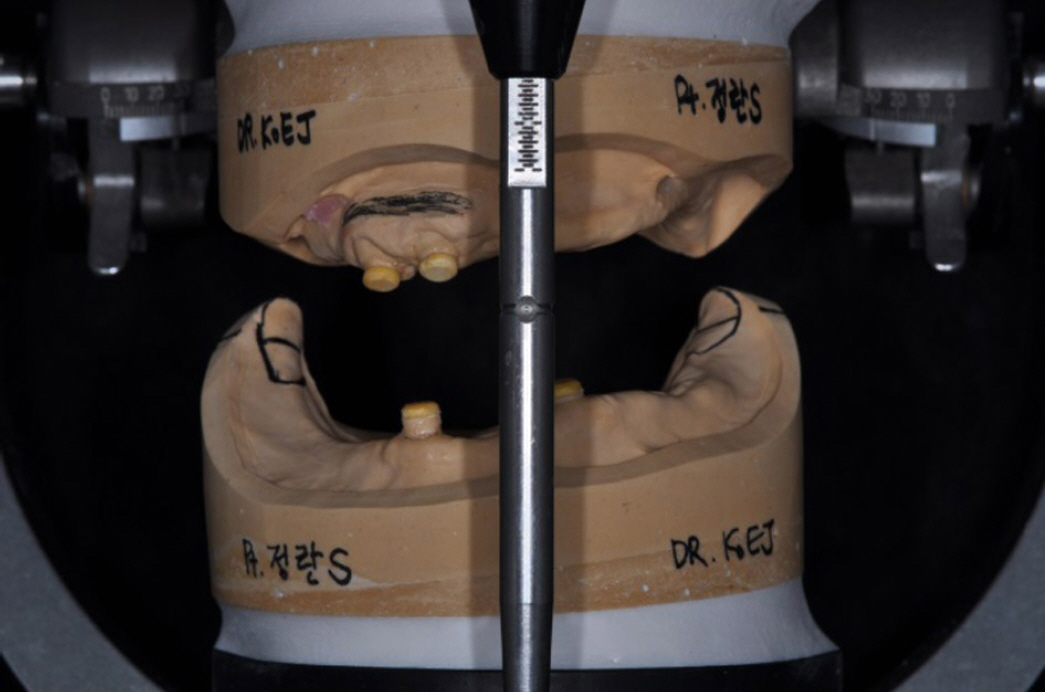J Korean Acad Prosthodont.
2015 Apr;53(2):150-156. 10.4047/jkap.2015.53.2.150.
Oral rehabilitation with magnetic overdentures for an old patient with complex systemic diseases
- Affiliations
-
- 1Department of Biomaterials and Prosthodontics, Kyung-Hee University Dental School Hospital at Gang-dong, Seoul, Republic of Korea. sbykmw@yahoo.co.kr
- KMID: 2195398
- DOI: http://doi.org/10.4047/jkap.2015.53.2.150
Abstract
- As dental implant treatment becomes popular for both partial and complete edentulous patients, old people with complex systemic diseases also tend to prefer implant-assisted-overdenture or implant-supported-fixed prostheses to conventional complete denture. In this case, 77-year-old female who was on medication for hypertension and osteoporosis and paralyzed on right side due to stroke visited for implant-assisted-overdenture on lower jaw. After oral and radiographic examination, root-assisted magnet overdenture on upper jaw and implant-assisted magnet overdenture on lower jaw are planned. Consequently, overdentures using self-adjusting magnetic attachment(SA) system on both jaws resulted in recovering satisfying function and retention, which is enable to insert and remove with only one hand.
Keyword
MeSH Terms
Figure
Cited by 1 articles
-
Overdentures of the patient with Parkinson’s disease: A case report
Byung-Kwee Min, Eun-Jung Shin, Mong-Sook Vang, Hong-So Yang, Sang-Won Park, Kwi-Dug Yun, Hyun-Pil Lim
J Korean Acad Prosthodont. 2015;53(4):352-358. doi: 10.4047/jkap.2015.53.4.352.
Reference
-
1. Kuoppala R, Nä pä nkangas R, Raustia A. Quality of Life of Patients Treated With Implant-Supported Mandibular Overdentures Evaluated With the Oral Health Impact Profile (OHIP-14): a Survey of 58 Patients. J Oral Maxillofac Res. 2013; 4:e4.
Article2. Kim YK, Yun PY. Dental implant therapy in the geriatric and medically compromised patients: A study on the early complications. J Korean Dent Assoc. 2004; 42:798–806.3. Song SI. Considerations for implants in the geriatric patient: review of the literature. J Dent Implant Res. 2014; 33:35–41.4. Schimmel M, Leemann B, Herrmann FR, Kiliaridis S, Schnider A, Müller F. Masticatory function and bite force in stroke patients. J Dent Res. 2011; 90:230–4.
Article5. Mü ller F, Duvernay E, Loup A, Vazquez L, Herrmann FR, Schimmel M. Implant-supported mandibular overdentures in very old adults: a randomized controlled trial. J Dent Res. 2013; 92:154S–60S.6. Fontijn-Tekamp FA, Slagter AP, Van Der Bilt A, Van 'T Hof MA, Witter DJ, Kalk W, Jansen JA. Biting and chewing in overdentures, full dentures, and natural dentitions. J Dent Res. 2000; 79:1519–24.
Article7. Feine JS, Carlsson GE, Awad MA, Chehade A, Duncan WJ, Gizani S, Head T, Lund JP, MacEntee M, Mericske-Stern R, Mojon P, Morais J, Naert I, Payne AG, Penrod J, Stoker GT Jr, Tawse-Smith A, Taylor TD, Thomason JM, Thomson WM, Wismeijer D. The McGill Consensus Statement on Overdentures. Montreal, Quebec, Canada. May 24-25, 2002. Int J Prosthodont. 2002; 15:413–4.8. Thomason JM, Kelly SA, Bendkowski A, Ellis JS. Two implant retained overdentures-a review of the literature supporting the McGill and York consensus statements. J Dent. 2012; 40:22–34.
Article9. Carlsson GE. Implant and root supported overdentures - a literature review and some data on bone loss in edentulous jaws. J Adv Prosthodont. 2014; 6:245–52.
Article10. Chadha GK, Ahmadieh A, Kumar S, Sedghizadeh PP. Osseointegration of dental implants and osteonecrosis of the jaw in patients treated with bisphosphonate therapy: a systematic review. J Oral Implantol. 2013; 39:510–20.
Article11. Montoya-Carralero JM, Parra-Mino P, Ram l′rez-Ferna′ndez P, Morata-Murcia IM, Mompea′n-Gamb l′n Mdel C, Calvo-Guirado JL. Dental implants in patients treated with oral bisphosphonates: a bibliographic review. Med Oral Patol Oral Cir Bucal. 2010; 15:e65–9.
Article12. Yang TC, Maeda Y, Gonda T, Kotecha S. Attachment systems for implant overdenture: influence of implant inclination on retentive and lateral forces. Clin Oral Implants Res. 2011; 22:1315–9.
Article13. Yang TC, Maeda Y, Gonda T. Clinical performance and satisfaction of removable prostheses with self-adjusting magnetic attachments. J Prosthet Dent. 2014; 111:131–5.
Article
- Full Text Links
- Actions
-
Cited
- CITED
-
- Close
- Share
- Similar articles
-
- Erratum: Oral rehabilitation with magnetic overdentures for an old patient with complex systemic diseases
- Survival and Success Rate of Implants in Overdentures: Analyzing Patient and Implant Factors
- Application of Laboratory Medicine in the Field of Oral Medicine
- Case Reports On The Magnetic Retained Overdentures
- Implant and root supported overdentures - a literature review and some data on bone loss in edentulous jaws












